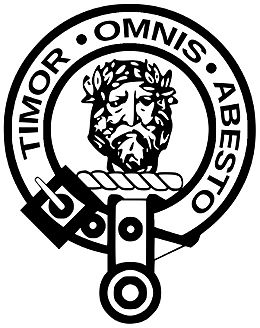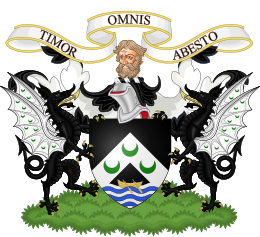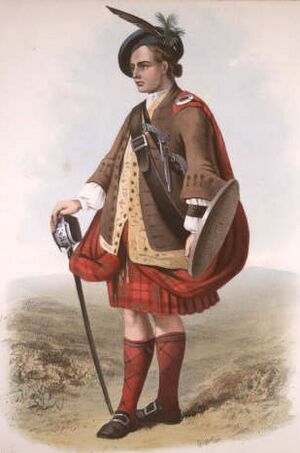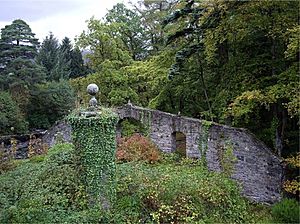Clan Macnab facts for kids
Quick facts for kids Clan Macnab |
|||
|---|---|---|---|

Crest: The head of a savage affrontée Proper
|
|||
| Motto | Timor Omnis Abesto (Let fear be far from all)
|
||
| Profile | |||
| Plant badge | Stone bramble or common heath | ||
| Chief | |||
 |
|||
| James William Archibald Macnab of Macnab | |||
| 24th Chief of Clan Macnab. | |||
| Historic seat | MacNab Castle | ||
|
|||
|
|||
|
|||
Clan Macnab is a historic Scottish clan from the Highlands of Scotland. Their name comes from the Scottish Gaelic words Mac An Aba, which means child of the abbot. This shows their ancient connection to religious leaders.
Contents
History of Clan Macnab
How the Clan Began
Old Stories of the Clan
Clan Macnab has a long history. Traditional stories say the clan started with a man named Abraruadh. He was an Abbot, a type of religious leader, in Glen Dochart and Strathearn. People believed Abraruadh was a younger son of Kenneth MacAlpin. Kenneth was the very first king of Scots.
Abraruadh was also thought to be related to Fergus, a king of Dál Riata. He was also a nephew of Saint Fillan. Saint Fillan founded a monastery in Glen Dochart way back in the 600s.
First Records of the Clan
One of the earliest written records of the Macnab family is from a document in 1124. Later, in 1296, a person named Malcolm de Glendochart signed the Ragman Rolls. This meant he agreed to follow Edward I of England.
The 1300s and Robert the Bruce
Angus Macnab was related to John III Comyn. John was killed by Robert the Bruce in 1306. Because of this, Angus Macnab joined forces with the Clan MacDougall. They fought against Robert the Bruce. Bruce was almost caught at the Battle of Dalrigh.
But Robert the Bruce became very powerful after winning the Battle of Bannockburn in 1314. As a result, the Macnab lands were taken away. Their important documents were also destroyed.
The Macnab clan's luck changed later. Angus's grandson, Gilbert, received new land documents from David II of Scotland in 1336. Gilbert's son, Sir Alexander Macnab, took over after him. Sir Alexander passed away around 1407.
The 1500s and Clan Fights
The Clan Macnab often fought battles with the Clan Neish. Their last big fight was the Battle of Glenboultachan. The Macnabs won this battle. Most of the Neishes were killed.
However, some Neishes survived. They continued to live on an island they called Neish Island. The Neishes kept causing trouble in the area. So, the feuds between the clans continued for some time.
The 1600s and Civil War
Chief Finlay Macnab was a peaceful leader. But he had to protect his lands. This was from the royalist forces of James Graham, 1st Marquess of Montrose. This happened in the mid-1640s during a civil war.
Finlay's son, known as Smooth John, was not as peaceful. He actually joined Montrose's army. John helped Montrose win the Battle of Kilsyth in 1645. Smooth John Macnab was put in charge of Montrose's own Kincardine Castle.
Later, General David Leslie, Lord Newark surrounded the castle. But the Macnab soldiers managed to break through the enemy lines. They fought their way to freedom. However, John Macnab was captured. He was taken to Edinburgh and sentenced to death. But he escaped the night before his execution! He then led 300 of his clansmen at the Battle of Worcester in 1651.
On July 13, 1680, the Chief of Clan Macnab and his followers fought in the Battle of Altimarlach. They supported Sir John Campbell. They were fighting against George Sinclair. This was over who had the right to certain lands and a noble title. Campbell won the battle. But Sinclair later went to court and was given the title and lands.
The 1700s and Jacobite Risings
Robert Macnab was the fourteenth chief of Clan Macnab. He married the sister of John Campbell, 1st Earl of Breadalbane and Holland. Because of this family connection to the Clan Campbell, he could not support the Jacobites. This was during the uprising of 1715. However, many of his clan members did join the Jacobite cause.
The fifteenth chief of the clan was a major in the government army. He was captured at the Battle of Prestonpans in 1745. He was then held as a prisoner in Doune Castle.
Clan Chief Today
The current chief of Clan Macnab is the 24th chief. His name is James William Archibald Macnab of Macnab. He became chief in 2013, after his father, James Charles Macnab of Macnab, passed away.
See also




